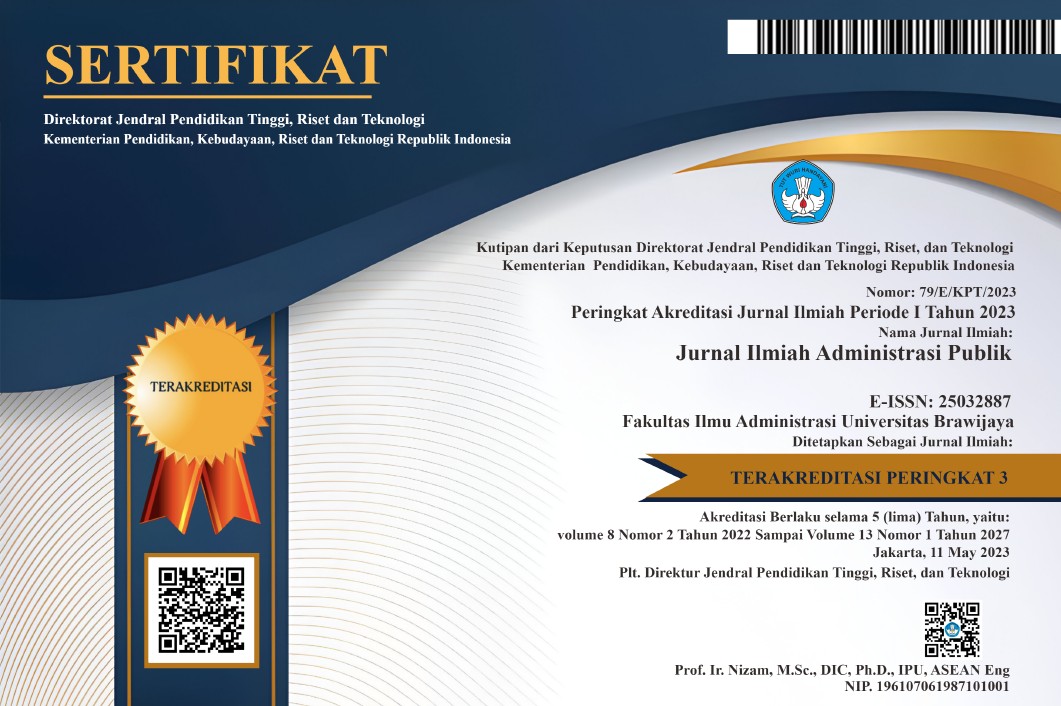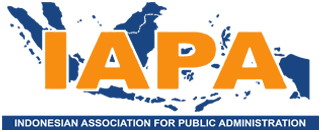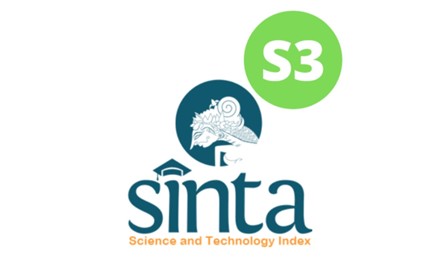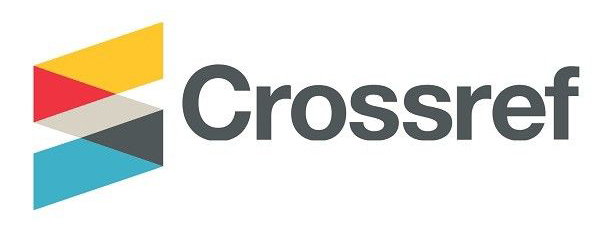Community Empowerment in Coastal Community: A Case Study of Social Forestry in North Sumatra, Indonesia
DOI:
https://doi.org/10.21776/ub.jiap.2020.006.01.8Keywords:
empowerment, social forestry, coastal communityAbstract
Coastal community has to be empowered because of their low capacities and reliance on mangrove ecosystem. This inquiry tries to reveal the process of empowerment consisted of powerlessness, support, wish, consciousness, confidence and empowered organization. Case study is employed in this research through documentation study, in-depth interviews and direct observations. Findings show that the process cannot fully adopt existing theory. Sometimes, “wish†precedes “supportâ€. Farmer group needs to raise its wishes to reach supports. In other word, the wish is a prerequisite for the support. In addition, economic incentive and the weak enforcement of rules has become the major constraints in the process. Therefore, external interventions must be maintained continuously, and rules must be enforced properly.References
Abdullah, K. et. al. (2014). “Community-Based Conservation in Managing Mangrove Rehabilitation in Perak and Selangor.†Procedia - Social and Behavioral Sciences 153:121-131
Adeleke, B. O. (2015). “Assessment of Residents’ Attitude towards Ecotourism in Kwazulu-Natal Protected Areas.†International Journal of Culture, Tourism and Hospitality Research 9(3):316-328
Agrawal A. and G. N. Yadama. (1997). “How do Local Institutions Mediate Market and Population Pressures on Resources? Forest Panchayats in Kumaon, India.†Development and Change 28:435-465
Agrawal, A. and J. Ribot. (1999). “Accountability in Decentralization: A Framework with South Asian and West African Environmental Casesâ€. The Journal of Developing Areas 33(4):473-502
Aheto, D. W. et. al. (2016). “Community-Based Mangrove Forest Management: Implications for Local Livelihoods and Coastal Resource Conservation along the Volta Estuary Catchment Area of Ghana.†Ocean & Coastal Management 127:43-54
Ahsan, Md. N. (2014). “Effects of Livelihood Strategies on Mangrove-Forest Resource: Do the Consumption Behaviour of Households.†Management of Environmental Quality: An International Journal 25(6):696-711
Akamani, K. et. al. (2015). “Barriers to Collaborative Forest Management and Implications for Building the Resilience of Forest-Dependent Communities in the Ashanti Region of Ghana.†Journal of Environmental Management 151:11–21
Alsop, R. et. al. (2006). Empowerment in Practice: From Analysis to Implementation. Washington DC, USA: World Bank
Andersen, J. and B. Siim. (2004). “Introduction: The Politics of Inclusion and Empowerment–Gender, Class and Citizenship.†in The Politics of Inclusion and Empowerment Gender, Class and Citizenship, edited by J. Andersen and B. Siim. New York, USA: Palgrave Macmillan. P.1-18
Anneboina, L. R. and K. S. K. Kumar. (2017). “Economic Analysis of Mangrove and Marine Fishery Linkages in India.†Ecosystem Services 24:114-123
Appiah, M. (2002). “Co-Partnership in Forest Management: The Gwira-Banso Joint Forest Management Project in Ghana.†Environment, Development and Sustainability 3:343-360
Argiolas, G. et. al. (2009). “Building Innovative Models of Territorial Governance.†Journal of Place Management and Development 2:178-210
Arhelo, B. A. (2017). "Capacity Building for Tourism and Logistics: Redefining the Role of Human Resources." Worldwide Hospitality and Tourism Themes 9(1):95-104
Armitage, D. R. et. al. (2009). “Adaptive Co-management for Social–Ecological Complexity.†Frontiers in Ecology and the Environment 7(2):95–102
Ayachi, H. and S. Jaouadi. (2017). Problems and Perspective of Ecotourism in the Island of Farasan: An Empirical Study Based on Survey Data. Society and Business Review 12(2):235-251
Balooni, K. and M. Inoue. (2007). “Decentralized Forest Management in South and Southeast Asia.†Journal of Forestry 105(8):414-420
Bandura, A. 1997. Self-efficacy: The Exercise of Control. New York, USA: W. H. Freeman and Co
Baral. N. (2013). “Evaluation and Resilience of Ecotourism in the Annapurna Conservation Area, Nepal.†Environmental Conservation 41(1):84–92
Baral, N. and M. J. Stern. (2011). “A Comparative Study of Two Community-Based Conservation Models in Nepal.†Biodiversity and Conservation 20:2407-2426
Barbier, E. B. (2016). “The Protective Service of Mangrove Ecosystems: A Review of Valuation Methods.†Marine Pollution Bulletin 109:676-681
Basyuni, M. et. al. (2016). “Identifikasi Potensi dan Strategi Pengembangan Ekowisata Mangrove di Desa Lubuk Kertang, Kecamatan Brandan Barat, Kabupaten Langkat Sumatera Utara.†Abdimas Talenta 1(1):31-38
Behera, B. and S. Engel. (2006). “Institutional Analysis of Evolution of Joint Forest Management in India: A New Institutional Economics Approach.†Forest Policy and Economics 8:350-362
Behera, B. (2009). “Explaining the Performance of State-Community Joint Forest Management in India.†Ecological Economics 69:177-185
Butts, T. and T. Sukhdeoâ€Singh. (2010). "Sustainable Tourism as a Tool for Conservation and Protection of the Amazon Rainforest in Guyana?" Worldwide Hospitality and Tourism Themes 2(2):173-185
Castañeda, C. (2000). “Criteria and Indicators for Sustainable Forest Management: International Processes, Current Status and the Way Ahead.†Unasylva 51:34-40
Chambers, R. (1983). Rural Development: Putting the Last First. Essex, England: Longman Inc
Cislaghi, B. et. al. (2016). Values Deliberation & Collective Action: Community Empowerment in Rural Senegal. New York, USA: Palgrave Macmillan
Clayton, A. H. et. al. (2014). "Tourism in a Transforming World Economy – The Impacts of the Brave New World: How Might Jamaica Achieve Long-Term Sustainable Development?" Worldwide Hospitality and Tourism Themes 6(2):191-196
Cobbinah, P. B. (2015). "Local Attitudes towards Natural Resources Management in Rural Ghana". Management of Environmental Quality: An International Journal 26(3):423-436
Corbridge, S. and S. Jewitt. (1997). “From Forest Struggles to Forest Citizens? Joint Forest Management in the Unquiet Woods of India’s Jharkhand.†Environment and Planning 29:2145-2164
Couto, R. A. (1989). “Catastrophe and Community Empowerment: The Group Formulations of Aberfan’s Survivors.†Journal of Community Psychology 17:236-248
Damastuti, E. and R. de Groot. (2017). “Effectiveness of Community-Based Mangrove Management for Sustainable Resource Use and Livelihood Support: A Case Study of Four Villages in Central Java, Indonesia.†Journal of Environmental Management 203:510-521
Davie, J. (1997). “Is Biodiversity Really the Link between Conservation and Ecologically Sustainable Management? A Reflection on Paradigm and Practice.†Pacific Conservation Biology 3:83-90
Dev, O. P. et. al. (2003). “Impacts of Community Forestry on Livelihoods in the Middle Hills of Nepal.“ Journal of Forest and Livelihood 3(1):64-77
Dimoska, T. and J. Kocevski. (2010). Creating Eco-Tourism Product. Tourism and Hospitality Management 2010, Conference Proceedings, P. 877-889
Farley, J. et. al. (2010). “Conserving Mangrove Ecosystem in Philippines: Transcending Disciplinary and Institutional Borders.†Environmental Management 45:39-51
Fuller, D. et. al. (2007). “Poverty, Indigenous Culture and Ecotourism in Remote Australia.†Development 50(2):141–148
FAO. (1994). Mangrove Forest Management Guidelines. FAO Forestry Paper No. 117. Rome, Italy: Food and Agriculture Organization of the United Nations
FAO. (2005). State of the World’s Forests 2005. Rome, Italy: Food and Agriculture Organization of the United Nations
FAO. (2006). Global Forest Resources Assessment 2005: Progress towards Sustainable Forest Management. FAO Forestry Paper No. 147. Rome, Italy: Food and Agriculture Organization of the United Nations
FAO. (2007). State of the World’s Forests 2007. Rome, Italy: Food and Agriculture Organization of the United Nations
FAO. (2016). State of the World’s Forests 2016: Forests and Agriculture: Land-Use Challenges and Opportunities. Rome, Italy: Food and Agriculture Organization of the United Nations
Giddens, A. (1984). The Constitution of Society: Outline of the Theory of Structuration. Cambridge, UK: Polity Press
Glaser, M. (2003). “Interrelations between Mangrove Ecosystem, Local Economy and Social Sustainability in Caete Estuary, North Brazil.†Wetland Ecology and Management 11:265-272
Hancock, D. R. and B. Algozzine. (2006). Doing Case Study Research: A Practical Guide for Beginning Researchers. New York, USA: Teachers College Press
Hastuti, T. K. and U. Yuliati. (2017). “A Model for Mangrove Forest Management Based on Community Empowerment in Bantul Regency.†Journal of Environmental Management and Tourism 8(6):1232-1237
Hegar, R. L. and J. M. Hunzeker. (1988). “Moving Toward Empowerment-based Practice in Public Child Welfare.†Social Work 33:499-502
Hodgdon, B. D. (2010). “Community Forestry in Laos.†Journal of Sustainable Forestry 29(1):50-78
Ilman, M. et. al. (2011). State of the Art Information on Mangrove Ecosystems in Indonesia. Bogor, Indonesia: Wetlands International - Indonesia Programme
Jaafar, M. et. al. (2013). "Natureâ€based Rural Tourism and Its Economic Benefits: A Case Study of Kinabalu National Park." Worldwide Hospitality and Tourism Themes 5(4):342-352
Jasanoff, S. (2006). “The Idiom of Co-production.†in States of Knowledge: The Co-production of Science and Social Order, edited by S. Jasanoff. London, UK: Routledge. P.1-12
Katz, R. (1984). “Empowerment and Synergy: Expanding the Community’s Healing Resources.†Prevention in Human Services 3(2-3):201-230
Kieffer, C.H. (1984). “Citizen Empowerment: A Developmental Perspective.†Prevention in Human Services 3(2-3):9-36
Kirst-Ashman, K. K. (2007). Human Behavior, Communities, Organizations, and Groups in the Macro Social Environment. Second Edition. California, USA: Thomson Brooks/Cole
KPH Wilayah I Stabat. (2018). Proposal Pengembangan Ekowisata Mangrove Lubuk Kertang Kecamatan Brandan Barat Kabupaten Langkat. North Sumatra, Indonesia: Kesatuan Pengelolaan Hutan Wilayah I Stabat
Kustanti, A. et. al. (2014). “Actor, Interest and Conflict in Sustainable Mangrove Forest Management—A Case from Indonesia.†International Journal of Marine Science 4(16):150-159
Lebel, L. et. al. (2004). “Nobody Knows Best: Alternative Perspectives on Forest Management and Governance in Southeast Asia.†International Environmental Agreements: Politics, Law and Economics 4:111-127
Lodhia, S. V. (2011). "Risk and Management of Climate Induced Disasters in Coastal Gujarat in India", Management of Environmental Quality: An International Journal 23(1):82-100
Malik, A. et. al. (2015). “Mangrove Exploitation Effects on Biodiversity and Ecosystem Services.†Biodiversity Conservation 24:3543-3557
Mann, M. (1986). The Sources of Social Power. Vol. 1. Cambridge, UK: Cambridge University Press
MartÃnez, Y. C. et. al. (2018). "Ecotourism as a Path to Sustainable Development in an Isolated Magic Town: The Case Study of La Trampa, Mexico." Journal of Tourism Analysis: Revista de Análisis TurÃstico, 25(1):23-38
Maryantika, N. and L. Chinsu. (2017). “Exploring Changes of Land Use and Mangrove Distribution in the Economic Area of Sidoarjo District, East Java Using Multi-Temporal Landsat Images.†Information Processing in Agriculture 4:321-332
Matiku, P. et. al. (2013). “The Impact of Participatory Forest Management on Local Community Livelihoods in the Arabuko‑Sokoke Forest, Kenya.†Conservation and Society 11:112-129
Maton, K. I. and J. Rappaport. (1984). “Empowerment in a Religious Setting.†Prevention in Human Services 3(2-3):37-72
McDougall, C. L. et. al. (2013). “Engaging Women and the Poor: Adaptive Collaborative Governance of Community Forests in Nepal.†Agriculture and Human Values 30:569-585
Milanovic, B. (2016). Global in Equality: A New Approach for the Age of Globalization. London, UK: Harvard University Press
Mitchell, J. (2012). “Value Chain Approaches to Assessing the Impact of Tourism on Low-Income Households in Developing Countries.†Journal of Sustainable Tourism 20(3):457-475
Mohamad, N. H. and A. Hamzah. (2013). "Tourism Cooperative for Scaling up Communityâ€Based Tourism." Worldwide Hospitality and Tourism Themes 5(4):315-328
Mohammed, A. J. and M. Inoue. (2013). “Exploring Decentralized Forest Management in Ethiopia Using Actor-Power-Accountability Framework: Case Study in West Shoa Zone.†Environment, Development and Sustainability 15:807-825
Mohammed, A. J. and M. Inoue. 2014. “A Modified Actor-Power-Accountability Framework (MAPAF) for Analyzing Decentralized Forest Governance: Case Study from Ethiopia.†Journal of Environmental Management 139:188-199
Mongbo, R. (2008). “State Building and Local Democracy in Benin: Two Cases of Decentralised Forest Management.†Conservation and Society 6:49-61
Nguyen, T. T. X. et. al. (2016). “Indicator-based Assessment of Climate-Change Impacts on Coasts: A Review of Concepts, Methodological Approaches and Vulnerability Indices.†Ocean and Coastal Management 123:18-43
Obiri, J. A. F. and M. J. Lawes. (2002). “Attitudes of Coastal-Forest Users in Eastern Cape Province to Management Options Arising from New South African Forest Policies.†Environmental Conservation 29:519-529
Pahl-Wostl, C. (2009). “A Conceptual Framework for Analyzing Adaptive Capacity and Multi-Level Learning Processes in Resource Governance Regimesâ€. Global Environmental Change 19:354-365
Parsons, R. J. (1989). “Empowerment for Role Alternative for Low Income Minority Girls.†Social Work with Groups 11(4):27-45
Peet, R. and Hartwick, E. (2009). Theories of Development: Contentions, Arguments, Alternatives. Second Edition. New York, USA: The Guilford Press
Persson, J., and M. Prowse. (2017). “Collective Action on Forest Governance: An Institutional Analysis of the Cambodian Community Forest System.†Forest Policy and Economics 83:70-79
Pieterse, J. N. (2010). Development Theory: Deconstruction/Reconstruction. Second Edition. London, UK: Sage Publication
Pomeroy, R. S. and M. B. Carlos. (1997). “Community-Based Coastal Resource Management in the Philippines: A Review and Evaluation of Programs and Projects, 1984-1994.†Marine Policy 21(5):445-464
PT. Pertamina EP Asset 1 Pangkalan Susu Field. (2018). Hijau Pesisir Ku, Lestari Alam Ku: Membangun Ekowisata Mangrove Menyelamatkan Ekosistem Pesisir Sumatera Utara di Desa Lubuk Kertang, Kecamatan Brandan Barat, Kabupaten Langkat. Paper Indonesia Green Award 2018. North Sumatra, Indonesia: PT. Pertamina EP Asset 1 Pangkalan Susu Field
Purnomo, B. et. al. (2017). “Analysis of Perception and Community Participation in Forest Management at KPHP Model Unit VII-Hulu Sarolangun, Jambi Province.†IOP Conf. Series: Earth and Environmental Science 70 (2017) 012034.
Ribot, J. C. (2002). African Decentralization: Local Actors, Powers and Accountability. Paper No. 8. Geneva, Switzerland: UNRISD
Ribot, J. C. (2003). Democratic Decentralization of Natural Resource: Institutionalizing Popular Participation. Washington DC, USA: World Resource Institute
Ritzer, G. (2011). Sociological Theory. Eighth Edition. New York, USA: McGraw-Hill Publications
Sadan, E. (2004). Empowerment and Community Planning. Translated by Richard Flantz. www.mpow.org/elisheva_sadan_empowerment.pdf. Downloaded on 21 March 2018
Simon, B. L. (1990). “Rethinking Empowerment.†Journal of Progressive Human Services 1(1):27-39
Singh, A. et. al. (2010). “Contribution of NTFPs in the Livelihood of Mangrove Forest Dwellers of Sundarban.†Journal of Human Ecology 29:191-200
Snyman, S. (2014). “The Impact of Ecotourism Employment on Rural Household Incomes and Social Welfare in Six Southern African Countries.†Tourism and Hospitality Research 0(0):1–16
Staples, L. H. (1990). “Powerful Ideas about Empowerment.†Administration in Social Work 14(2):29-42
Sunderlin, W. D. et. al. (2005). “Livelihoods, Forests, and Conservation in Developing Countries: An Overview.†World Development 33(9):1383–1402
Uddin, M. S. et. al. (2013). “Economic Valuation of Provisioning and Cultural Services of a Protected Mangrove Ecosystem: A Case Study on Sundarbans Reserve Forest, Bangladesh.†Ecosystem Services 5:88-93
UNDP. (2010). Human Development Report 2010 – 20th Anniversary Edition. The Real Wealth of Nations: Pathways to Human Development. New York, USA: United Nations Development Programme
Wandersman, A. and P. Florin. (2000). “Citizen Participation and Community Organizations.†in Handbook of Community Psychology, edited by J. Rappaport and E. Seidman. New York, USA: Plenum Press. P.247-272
Wang, S. (2004). “One Hundred Faces of Sustainable Forest Management.†Forest Policy and Economics 6:205-213
Yin, R. K. (2009). Case Study Research: Design and Methods. Fourth Edition Volume 5. California, USA: Sage Publications, Inc
Zimmerman, M. A. and J. Rappaport. (1988). “Citizen Participation, Perceived Control, and Psychological Empowerment.†American Journal of Community Psychology 16(5):725-750
Zimmerman, M. A. (2000). “Empowerment Theory: Psychological, Organizational and Community Levels of Analysis.†in Handbook of Community Psychology, edited by J. Rappaport and E. Seidman. New York, USA: Plenum Press. P.43-63
Downloads
Published
Issue
Section
License
If your paper is accepted, the author identified as the formal corresponding author for the paper will receive an email prompting them to login into Author Services; where via the JIAP Author Licensing Service they will be able to complete the license agreement on behalf of all authors on the paper.














